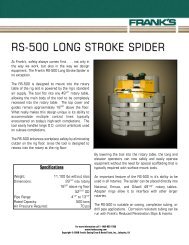Master Mag Templet - Frank's International, Inc.
Master Mag Templet - Frank's International, Inc.
Master Mag Templet - Frank's International, Inc.
Create successful ePaper yourself
Turn your PDF publications into a flip-book with our unique Google optimized e-Paper software.
The Greatest Two Minutes in Sports by<br />
At the 48,500-seat Churchill Downs<br />
racetrack in Louisville, Kentucky,<br />
twin spires atop the grandstand<br />
beckon visitors to The Kentucky<br />
Derby, the premier race of the Triple<br />
Crown run on the first Saturday in<br />
May. The Triple Crown, won by only<br />
11 horses since 1919, is completed by<br />
the Preakness in mid-May and the<br />
Belmont in early June. The Kentucky<br />
Derby, attracting crowds of more than<br />
100,000 spectators and watched by<br />
millions on television, has evolved<br />
into an American tradition, filled with<br />
history, hats, and (of course) horses.<br />
Times Gone By<br />
The derby’s legacy started 128 years<br />
ago. To achieve the same attention<br />
afforded to England’s Epsom Derby,<br />
Meriwether Louis Clark Jr., builder of<br />
Churchill Downs, visited England to<br />
study its tracks and races. On May<br />
17, 1875, the first horses broke from<br />
their starting gates and galloped into<br />
history. Nevertheless, by 1902<br />
Colonel Matt J. Winn, a promoter,<br />
Mali R. Schantz-Feld<br />
More than just a race, The Kentucky Derby combines a time-honored<br />
tradition of equine excellence and just horsing around.<br />
needed to travel to New York to persuade<br />
owners to enter their threeyear-old<br />
horses in the Derby to keep<br />
the track from bankruptcy. Fortunately,<br />
his work paid off, and by<br />
1920, the Derby had become the<br />
best-known race in North America.<br />
Modern spectators at the track can<br />
monitor their horse’s progress with<br />
program numbers, public address systems,<br />
or closed-circuit televisions. In<br />
early racing days, silks of a rainbow<br />
of colors were necessary to distinguish<br />
between the jockeys.<br />
The tradition of wearing silks has<br />
developed even more creativity today.<br />
Whereas single colors once stood for<br />
one’s status, such as red representing<br />
a particular duke, while blue represented<br />
a certain earl, now a combination<br />
of colors and designs represents<br />
each jockey and horse. The jockey’s<br />
room at Churchill Downs is adorned<br />
with hundreds of silks hung on pegs<br />
in the order of each jockey’s races<br />
for the day.<br />
Stephen Foster brought music to the<br />
ears of Kentucky Derby participants<br />
with “My Old Kentucky Home.” The<br />
song, reportedly played for the first<br />
time at the derby in 1921, later<br />
became a traditional accompaniment<br />
to the post parade. Most years, since<br />
1936, the song has been performed<br />
by the University of Louisville<br />
Marching Band. To honor the composer,<br />
the Derby initiated the Stephen<br />
Foster Handicap in 1982.<br />
The Winner’s Circle<br />
The 1-1/8 mile race is now a Grade II<br />
event garnering a purse of $750,000,<br />
the richest stakes at the Downs outside<br />
of the Derby. As the winning<br />
horse is escorted to the coveted winner’s<br />
circle, the jockey, owner, trainer,<br />
and breeder team share the rewards of<br />
their efforts. The horse is covered<br />
with a blanket sewn with 500 of the<br />
darkest red roses and greens. Perhaps<br />
it was because of this aromatic accolade<br />
that the late Bill Corum, a New<br />
York sports columnist and later Presi-<br />
23

















